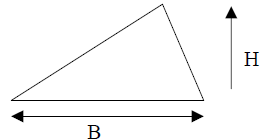Section 5.1: Introduction to Factoring
This is the chapter in which we learn the very important
skill of factoring
polynomials, especially trinomials. Please remember that when we ask you to
factor something, we are asking you to write it as a product. We start
out by
learning how to factor out the greatest common factor from an expression.
A. A Little Review: Multiply the following :
1. 7(2x + 5)
2. 2x(5x2 + 3)
3. 3x2(5x – 7)
4. 3x3(2x2 – 3x + 5)
B. Factoring out the greatest common factor is just the
opposite of what you did in
problems #1 – 4 above. We start with the answer and work backwards, writing
it as a product. Factor out the greatest common factor for the following
problems.
1. 14x + 21
2. 7x3 – 4x2
3. 16x4 – 20x2 – 16x
4. 5ab2 + 10a2b2 + 15a2b
5. 49xy – 21x2y2 + 35x3y3
C. Factoring by Grouping: We will use this technique
when we have 4 terms
that we want to factor. Sometimes polynomials with four terms contain
binomial factors. In these cases, we group the first two terms and factor out
the
greatest common factor from them, then we group the second two terms and
factor out the greatest common factor from them. Hopefully at this point, we
have a common factor that will allow us to factor the original expression.
Work through the following examples.
These types of problems are best manipulated mentally
before writing anything
down. Look at this first problem- here we see a common x in the first two
terms. If we factor out the x then we are left with y+2. Now look at the second
pair of terms. Here we see a common 4 and, if we factor that out, we are left
with y+2 for a factor of the second two terms. So x+2 is the common binomial
factor of the this four term polynomial.
1. xy + 2x + 4y + 8
2. 3ax + 21x – a – 7
3. x3 – 5x2 – 4x + 20
4. 8x3 – 12x2 + 14x – 21
In this section of the text, we learn how to factor trinomials. This is one
of the
most important parts of this course! The ability to factor will make or break
you in
the next algebra course that you take. The text shows you a method of trial and
error for factoring.
See pages 80 and 84 of this book for guidance on
determining the algebraic signs
in the factors.
Successful factoring requires PRACTICE, PRACTICE,
PRACTICE!!!
Plan to spend some time on this concept – it will pay off
“BIG TIME” later in this
course and in the future!
A. A review of multiplication using the table: Multiply
the following using the
table:
1. (x + 7)(x – 5)
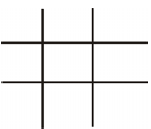
2. (x + 2)(x + 6)
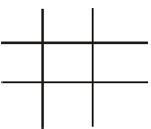
B. Factor the following:
1. x2 + x – 12
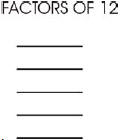
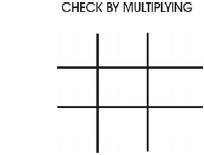
i. Determine the signs
ii. List the factors of 12
iii. Enter the two selected factors
iv. Check ans.
x =( x )( x )
2. x2 – 5x – 24
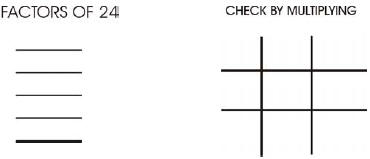
x =( x )( x )
3. x2 + 8x + 12
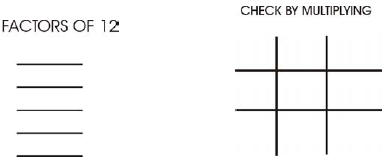
x =( x )( x )
4. x2 + x – 42
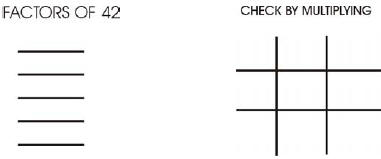
x =( x )( x )
5: Factor Completely: x4 – 11x3 + 24x2 (Make your own
table)
6: Factor Completely: 3x3 – 3x2 – 18x (Make your own table)
7: 6x − 72 + x2 (First put in standard form, make own table)
8: 11− 3w+ w2 (A polynomial that will not factor is called “Prime”)
GET IT RIGHT
FACTORING
X2 + BX +C
1. REARRAGE TERMS IN PROPER ORDER: X 2 + X − 42
2. PLACE THE PARENTHESIS : X 2 + X − 42=( )( )
3. PUT THE X’S IN PLACE: X 2+ X − 42=( X )( X )
4. NOW THE AGEBRAIC SIGNS. THE SIGNS CAN BE FOUND BY
EXAMINING THE QUADRATIC. THERE ARE ONLY FOUR CASES.


In the above figure the P’s stand for Plus and the M for Minus. Imagine PoP
(dad) sitting on a couch with a soda PoP in one hand, a bowl of PluMs in the
other and MoM standing nearby with a MoP ready to clean up the mess.
In this case the signs are Plus and Minus: X 2 + X
− 42=( X + )( X − )
5. Now the numbers. The product of
the two numbers must
equal the constant in the quadratic and the sum must be the
coefficient of middle term . So- on a piece of paper, list the prime
factors of the constant and include 1 as a factor. For 42 these factors
are 1,2,3,7. From these values make all possible pairs as shown at the
right. |
 |
6. The correct factors are 6 and 7 since the product is 42 and the difference
is 1.

7. The final , most important step, is to check your
answer by multiplication!
Section 5.3: Factoring Trinomials of the Type ax2 + bx
+c
In this section we practice how to factor trinomials that have a leading
coefficient
other than one. These usually take a little more time and effort to figure out.
We
will also work on factoring trinomials that require us to factor out the
greatest
common factor first, before we factor the trinomial. Learn these skills well!!!
There are two ways to approach problems like these :
a) Trial and error: Try all combinations of the factors of the first and
last terms. Can be very time consuming but if you stick with it you
will eventually arrive at the correct answer.
b) Factor by grouping approach: This is much faster but requires that
you remember the various steps.
A. Some practice problems:
1. 2x2 + 5x + 3
2. 3x2 – 2x – 5
3. 6x2 – 13x + 6
4. 4x2 + 12xy + 9y2 (Make your own table for this one)
5. 4x2 - 4x – 15 (Make your own table for this one)
B. Factoring problems where you need to factor out the
greatest common factor
first – some examples:
1. 6x2 – 51x + 63

2. 18a2 + 48a + 32
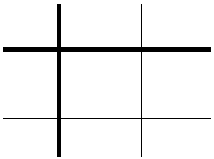
3. 10x4 + 7x3 – 12x2
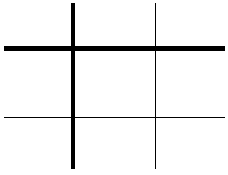
4. 6x3 + 19x2 + 10x
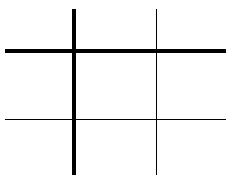
GETTING IT RIGHT
SIGNS IN THE FACTORS

Look at the sign of the last term in the quadratic. If it is negative then
one of the
factors must be POSITIVE ; the other NEGATIVE. This means the sign of the
middle term can be either PLUS or MINUS depending on the size of the constants
in the factors.

If the sign of the last term in the quadratic is PLUS then the signs in the
factors
must both be plus OR both must be negative. If the sign of the middle term in
the
quadratic is plus then both factors are plus (bottom figure); if the sign of the
middle
term in the quadratic is minus then both factors are minus (top figure).

Section 5.4: Factoring Perfect- Square Trinomials and Diff. of Squares
In this section we introduce you to a special case in factoring known as the
difference between two squares. We have already looked at this subject back in
Section 4.5. These are very easy to factor once you recognize them. We will also
look at factoring perfect-square trinomials.
A. A quick review of multiplication - Multiply the
following:
1. (x – 5)(x + 5) =
2. (2x – 7)(2x + 7) =
3. (3x + 2)(3x – 2) =
4. Do you remember the pattern in the 3 products given above?
B. Using the pattern you see above, how would you factor
the following? You
won’t need the table to factor these special cases, but you could use it if you
wanted to do so.
1. x2 – 49 =
2. y2 – 64 =
3. 9x2 – 36 =
4. 81x2 – 1 =
5. 4w2 – 25 =
C. Factoring Perfect Squares : Use the table to factor the
following:
1. x2 + 6x + 9 =
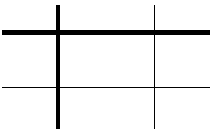
2. m2 + 12m + 36 =
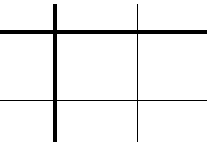
3. 25x2 + 10xy + y2 = (Make your own table here)
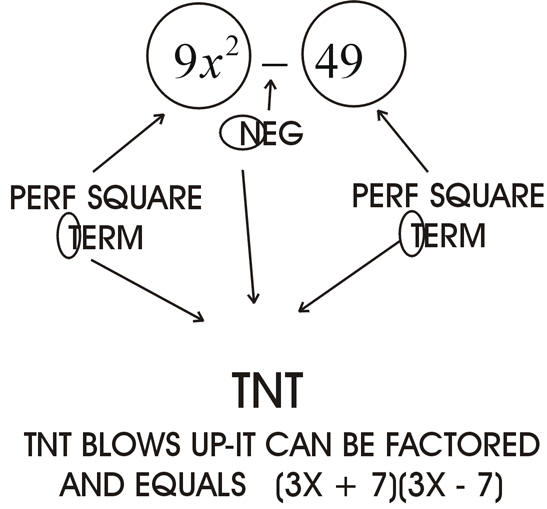
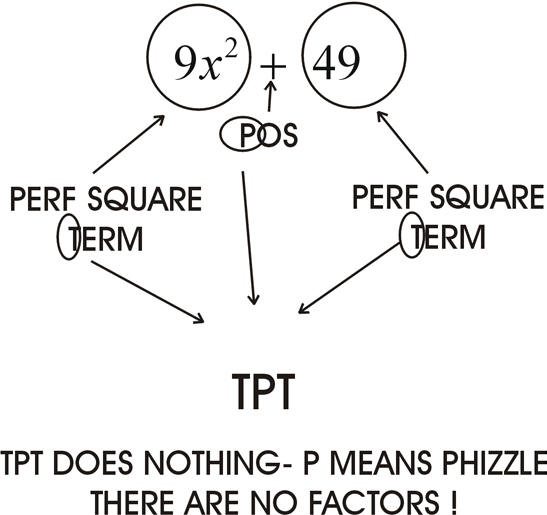
Section 5.5: Factoring: A General Strategy
In this section of the text we simply give you a lot of trinomials to
factor, but we
don’t tell you which kind you are dealing with. You will need to learn how to
factor any trinomial, no matter what kind it is. Basically, you just need to use
you
table, or recognize it as a special case and deal with it that way. Work the
following problems to practice your factoring skills.
A. Read through the “To Factor a Polynomial”
highlight on page 334 of your
text.
1: Arrange terms in proper order (highest exponent first).
2: If the first term is negative, divide by –1 and place terms in parenthesis.
Now
factor the expression inside the parenthesis. But don’t throw away the negative
sign in the final answer.
−x2 + 2x + 3 = − (x2 − 2x − 3)
3: Look for other common factors
4: Two terms: Look for difference of squares.
Three terms: Is it a perfect square; if not then use trial and error to factor.
Four terms: Look for a binomial factor- then use the grouping method.
5: Factor completely. Look at your answer. Verify there are no more factors.
6: Check by multiplying.
B. Work through the following problems: (Make your own
tables)
1. 2x5 – 8x3 =
2. 3x4 – 18x3 + 27x2 =
3. y3 + 25y =
4. 6a2 – 11a + 4 =
5. 6x3 – 12x2 – 48x =
6. 2ab5 + 8ab4 + 2ab3 =
7. xy + 8x + 3y + 24 =
This is the section where we begin to see why factoring is sooooo important.
In
this section we will learn to solve polynomial equations , especially quadratic
equations.
A. Definition: A quadratic equation is said to be in
standard form if it is written as
follows: ax2 + bx + c = 0.
1. Notice that the equation is set equal to zero.
2. Notice that the terms are in descending order of degree .
3. First term is Positive.
B. A second Definition: The Zero Property :
1. If a⋅b = 0 , then either a = 0, or b = 0.
2. Believe it or not, this property is the foundation for solving polynomial
equations. We will use it a lot!!!
C. Strategy for Solving a Quadratic Equation by Factoring:
1. Put the equation in standard form: Write it as: ax2 + bx + c = 0. This first
step is one of the most important and often takes the most work.
2. Factor the quadratic equation completely!
3. Set each factor equal to zero by using the zero property described above.
4. Solve each of the equations created in #3 above.
5. Check each solution .
D. Work through the following homework problems for
practice. Be sure to work
through the checklist given above.
1. (a + 6)(a – 1) = 0
2. m(2m – 5)(3m – 1) = 0
3. a2 – 11a + 30 = 0
4. 100x2 – 300x + 200 = 0
5. a2 – 36 = 0
6. x2 + 5x = 0
7. 9x2 = 12x – 4
8. x(12 – x) = 32
9. (y + 4)2 = y + 6
10. 9y3 + 6y2 – 24y = 0
12. x3 + 5x2 – 9x – 45 = 0
Section 5.7: Solving Applications and the Pythagorean
Theorem
In this section we will solve application problems that require the use of
quadratic
equations. Work through the following problems to see how this is done.
A. Some Practice homework problems:
1. The product of two consecutive odd integers is 99. Find the two integers:
2. One number is 4 times another. Their product is 4 times
their sum. Find
the numbers.
3. The length of a rectangle is 3 more than twice the
width. The area is 44
square inches. Find the dimensions.
4. The hypotenuse of a right triangle is 15 inches. One of
the legs is 3 inches
more than the other. Find the lengths of the two legs.
Remember the Pythagorian
Theorem:
In a right triangle:
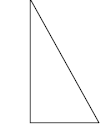 |
5. The height of a triangle is 3 cm less than the length
of the base. The area is 35
square cm. Find the height and the base.
